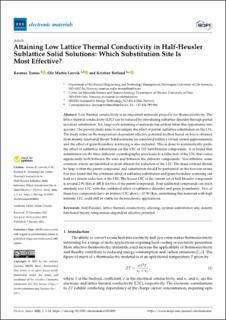| dc.contributor.author | Tranås, Rasmus André | |
| dc.contributor.author | Løvvik, Ole Martin | |
| dc.contributor.author | Berland, Kristian | |
| dc.date.accessioned | 2023-01-09T09:05:33Z | |
| dc.date.available | 2023-01-09T09:05:33Z | |
| dc.date.created | 2022-08-05T17:06:16Z | |
| dc.date.issued | 2022 | |
| dc.identifier.citation | Electronic Materials. 2022, 3 (1), | en_US |
| dc.identifier.uri | https://hdl.handle.net/11250/3041800 | |
| dc.description.abstract | Low thermal conductivity is an important materials property for thermoelectricity. The lattice thermal conductivity (LTC) can be reduced by introducing sublattice disorder through partial isovalent substitution. Yet, large-scale screening of materials has seldom taken this opportunity into account. The present study aims to investigate the effect of partial sublattice substitution on the LTC. The study relies on the temperature-dependent effective potential method based on forces obtained from density functional theory. Solid solutions are simulated within a virtual crystal approximation, and the effect of grain-boundary scattering is also included. This is done to systematically probe the effect of sublattice substitution on the LTC of 122 half-Heusler compounds. It is found that substitution on the three different crystallographic sites leads to a reduction of the LTC that varies significantly both between the sites and between the different compounds. Nevertheless, some common criteria are identified as most efficient for reduction of the LTC: The mass contrast should be large within the parent compound, and substitution should be performed on the heaviest atoms. It is also found that the combined effect of sublattice substitution and grain-boundary scattering can lead to a drastic reduction of the LTC. The lowest LTC of the current set of half-Heusler compounds is around 2 W/Km at 300 K for two of the parent compounds. Four additional compounds can reach similarly low LTC with the combined effect of sublattice disorder and grain boundaries. Two of these four compounds have an intrinsic LTC above ∼15 W/Km, underlining that materials with high intrinsic LTC could still be viable for thermoelectric applications. | en_US |
| dc.language.iso | eng | en_US |
| dc.publisher | MDPI | en_US |
| dc.rights | Navngivelse 4.0 Internasjonal | * |
| dc.rights.uri | http://creativecommons.org/licenses/by/4.0/deed.no | * |
| dc.subject | temperature-dependent effective potential | en_US |
| dc.subject | density functional theory | en_US |
| dc.subject | optimal substitution site | en_US |
| dc.subject | alloying | en_US |
| dc.subject | lattice thermal conductivity | en_US |
| dc.subject | half-Heusler | en_US |
| dc.title | Attaining Low Lattice Thermal Conductivity in Half-Heusler Sublattice Solid Solutions: Which Substitution Site Is Most Effective? | en_US |
| dc.title.alternative | Attaining Low Lattice Thermal Conductivity in Half-Heusler Sublattice Solid Solutions: Which Substitution Site Is Most Effective? | en_US |
| dc.type | Peer reviewed | en_US |
| dc.type | Journal article | en_US |
| dc.description.version | publishedVersion | en_US |
| dc.rights.holder | Copyright: © 2022 by the authors. Licensee MDPI, Basel, Switzerland. This article is an open access article distributed under the terms and conditions of the Creative Commons Attribution (CC BY) license (https:// creativecommons.org/licenses/by/ 4.0/). | en_US |
| dc.source.pagenumber | 14 | en_US |
| dc.source.volume | 3 | en_US |
| dc.source.journal | Electronic Materials | en_US |
| dc.source.issue | 1 | en_US |
| dc.identifier.doi | 10.3390/electronicmat3010001 | |
| dc.identifier.cristin | 2041426 | |
| dc.relation.project | Norges forskningsråd: 314778 | en_US |
| dc.relation.project | Norges forskningsråd: 246687 | en_US |
| dc.relation.project | Sigma2: NN9711k | en_US |
| dc.relation.project | Sigma2: NN2615k | en_US |
| cristin.ispublished | true | |
| cristin.fulltext | original | |
| cristin.qualitycode | 1 | |

